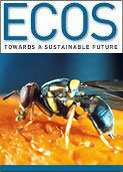
|
Published: 6 November 2013
What's the washup from this chemical life?
Every day, Australians flush relatively small – but significant – amounts of chemicals down the drain, many excreted from their own bodies.
These micropollutants – from the diverse medicines, personal hygiene products, household cleaning agents, dietary supplements and other chemical products we now use routinely – make their way to wastewater treatment plants. From there, most are released into our waterways, with potentially devastating consequences for the aquatic fauna exposed to them.
‘Micropollutants is a term which is commonly used for contaminants that occur in the environment at very low concentrations, so here we are talking about micrograms per litre, or even nanograms per litre of water,’ said environmental chemist Dr Rai Kookana, senior principal research scientist at CSIRO Land and Water.
‘The interesting thing is that even at these low concentrations, they have the potential to impact on the health and wellbeing of the exposed organisms.’
The most well-known class of micropollutants is the endocrine-disrupting chemicals (EDCs). These either mimic hormones or interact with receptors for those hormones. The resultant effects include intersex conditions, such as male fish developing female reproductive organs, or producing egg yolk proteins normally only found in females; and changes in reproductive behaviour.
The most notorious of the endocrine disrupting chemicals is DDT. It was first used as a pesticide from the 1930s but was eventually banned from agricultural use after it was found to affect, among other things, female reproductive tract development.
However, DDT was just the tip of the iceberg. Other endocrine-disrupting chemicals are still in widespread use, such as bisphenol A, found in plastics; and polybrominated diphenyl ethers, flame retardants used in the plastic cases of electronic equipment.
In the last decade or so, awareness has emerged of another potent source of endocrine-disrupting chemicals and other micropollutants: human beings.
At a recent symposium titled ‘What’s In Our Water’, researchers gathered from around Australia and overseas to present new data on micropollutants in the environment. The issue of pharmaceuticals and personal care products was a key theme.
‘In the last 10-15 years, scientists have identified very potent pharmaceutical compounds such as the synthetic hormone used in the contraceptive pill, called ethinylestradiol,’ said Dr Kookana.
‘In the same period, another group of compounds were identified called antimicrobial agents such as triclosan and triclocarban, which are used in soaps, shampoos and some other household products.’
These compounds find their way into the wastewater stream when we wash our hands, clothes or hair; when we bathe or shower our bodies after taking medications; and when we throw waste medications down the sink or toilet. Unfortunately, these compounds are tricky to remove once they are in the wastewater.
Dr Mike Williams is an environmental chemist and toxicologist at CSIRO Land and Water. He and his colleagues recently looked at the concentrations of six key pharmaceutical compounds in the discharge from three wastewater treatment plants.
Two of those compounds – ethinylestradiol and the non-steroidal anti-inflammatory, diclofenac – are known to have environmental consequences. Diclofenac was implicated in a massive crash in vulture populations in India, causing acute kidney failure in birds that fed on the carcasses of animals treated with the drug.

|
|
The non-steroidal anti-inflammatory drug, diclofenac, sometimes used on livestock, has been blamed for a dramatic decline in India’s vulture populations. Credit:
Yann/Wikimedia Commons
|
The other compounds – the antidepressant venlafaxine, cancer drug methotrexate, anticonvulsant carbamazepine, and antihypertensive propanolol – were chosen because of the high volume of these pharmaceuticals consumed in Australia.
‘Some drugs aren’t removed at all during the wastewater treatment process so they’re quite good tracers – something which can track wastewater effluent in the environment. If we find the tracer drugs in the environment then we’re fairly sure that’s where our wastewater effluent is reaching as well,’ said Dr Williams.
The team’s results confirmed what has been found in other parts of the world: that for the most part, wastewater treatment plants are not designed to eliminate compounds that exist at such low concentrations.
To upgrade treatment plants to the point where they could remove these compounds is almost prohibitively expensive. Dr Williams referred to a recent estimate of around €35 billion for the UK alone.
But the case against micropollutants isn’t as straightforward as it appears. While the environmental evidence against DDT has been overwhelming, other micropollutants aren’t presenting such a clear ‘smoking gun’.
Ecotoxicologist, Dr Anu Kumar – a principal research scientist and team leader at CSIRO Land and Water – says that just because micropollutants are present in measurable quantities in the environment, that doesn’t always mean they are having an impact on the flora and fauna in that environment.
Her role is to try to work out the effects of micropollutants, if any, on native Australian fauna.
‘In Europe, Northern America and Japan they’re using small, test model fish species such as zebrafish, fathead minnow, and Japanese medaka. These are not the fish that are in our freshwater, so firstly we have to develop the biomarkers – that takes a while – and then validate them. Then we can do the assessment,’ said Dr Kumar.
Dr Kumar was recently involved in a study examining the presence and effects of micropollutants, including endocrine disrupting chemicals, in parts of Darwin Harbour that receive effluent from sewage treatment plants.
'Micropollutants were detected in effluent, receiving water and sediment samples – similar to what has been reported overseas and even in temperate regions within Australia. But the concentrations generally were very low,’ she said.
Dr Kumar then screened the compounds for endocrine-disrupting activity and confirmed that there was oestrogenic and androgenic activity (oestrogens and androgens are female and male sex hormones, respectively). However, she said the impact of these chemicals on fish and other animals was unknown.
It’s a task complicated by the fact that we still have so much to learn about the biology of our native fauna.
‘We started working with Murray rainbowfish six or seven years ago and we are still trying to understand the molecular endocrinology of this fish,’ said Dr Kumar. ‘This information is critical to assess the adverse effects of micropollutants and treated effluent discharges in the Australian riverine environment.’
Dr Kookana adds that generally, Australian scientists are still trying to determine the extent of our fauna’s exposure to micropollutants, and the effect these synthetic chemicals may be having.

|
|
Australian scientists are still trying to determine the impact of micropollutants on native fauna in rivers, estuaries and other receiving waters. Credit:
CSIRO
|
The situation is further complicated by the fact that these chemicals can break down into different compounds that might have their own toxicities. Plus, compounds that are harmless by themselves may become toxic when they interact with other compounds in the environment.
‘As the data comes to hand, we can provide this information publicly, confident that we have examined this issue, we’ve done monitoring and other assessments and hopefully we can reassure the community that the situation is not as alarming as people might have thought,’ Dr Kookana said.
Or, the data might suggest that a response is needed. In this case, Dr Kookana says that a solid evidence base – and well-funded research – will be vital to informing policy decisions concerning the chemicals we send down our drains on a daily basis.




